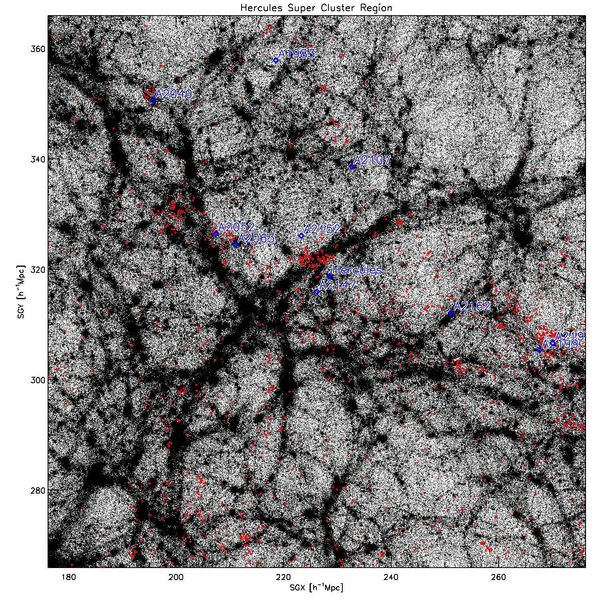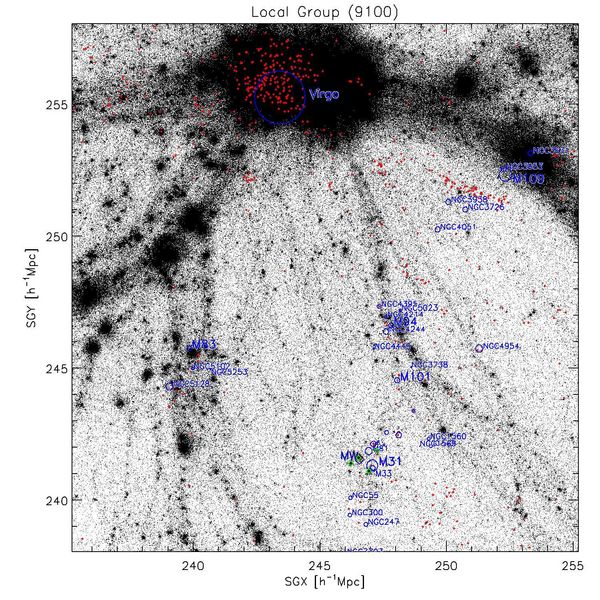ASTROPHYSICS
Our Cosmic Home in a Box: SLOW Dancing Galaxies
Principal Investigator:
Jenny G. Sorce(1), Klaus Dolag(2)
Affiliation:
(1) Leibniz-Institut für Astrophysik Potsdam/AIP (Germany) and Centre de Recherche Astrophysique de Lyon (France), (2) Universitäts-Sternwarte, Ludwig-Maximilians-Universität München (Germany)
Local Project ID:
pr74do
HPC Platform used:
SuperMUC of LRZ
Date published:
The neighbourhood in the immediate vicinity of the Milky Way is known as the “Local Group”. It is a binary system composed of two averaged sized galaxies (the Milky Way and Andromeda) dominating a volume that is roughly ~7 Mpc in diameter. At a distance of around 15Mpc, the Virgo cluster comes into view as the main defining feature of our neighbourhood on these scales. Beyond Virgo, a number of well known and well observed clusters like Centaurus, Fornax, Hydra, Norma, Perseus and Coma dominate the night sky. This is our cosmic neighbourhood. The goal of this project is, for the first time, to perform targeted, state of the art hydro-dynamical simulations covering this special region of the universe and to compare the results with various detailed observational data that are, as such, only available for local structures (e.g. galaxies and galaxy clusters).
Introduction
Our Cosmic Home, the local volume of the Universe that is centered on us and extends over 1 billion light-years, is a formidable site for detailed observations. Therefore, cosmological Simulations of the LOcal Web (SLOW) including galaxies (clumps of dust, stars and planets), rather than any other part of the cosmic web, are perfect tools to test our formation and evolution theories of galaxies and galaxy clusters down to the details. Indeed, structure formation is studied through the equation of motion of tracer particles in initial conditions. However, a random realization of the cosmological model used as initial conditions does not necessarily reproduce the local structure making direct comparisons with the local observations extremely challenging.
The 'SLOW dancing galaxies' project follows the evolution of dark (nature of most of the matter in the Universe) and baryonic (the directly visible Universe) matter within a simulation volume that stands for our cosmic neighborhood out to a distance of 1 billion light-years. The initial conditions for such simulations are obtained with sophisticated algorithms that take into account the position and motion estimates of thousands of galaxies within our local volume. These local measurements allow to constrain the initial conditions that, in return, when motions since early times until today are followed according to the gravity laws, lead to the observed local large scale structure. When in addition, the baryonic matter follows hydrodynamical laws (together with recipes to model the birth of stars), the galaxy population is also simulated. The latter can be directly compared to the observed galaxy population.
Simulations resembling the local large scale structure and resolving its galaxy population need to follow a very large dynamical range (sampled with several tens of billion resolution elements) and therefore can only be performed on the largest supercomputers.
Results and Methods
Simulating a 1 billion light-years box representing our Cosmic Home including galaxies down to the mass of our Milky Way (e.g. resolving masses about 1011-1012 times the solar mass with at least several hundreds of particles) constitutes a formidable computational challenge. A single, dark-matter-only simulation reaching such a high resolution in this large volume requires already an amount of 0.5 Million CPUh of computing time and typically runs on 16 thousands computing cores.
Building the necessary initial conditions requires stringent preliminary steps. These steps include preparing the observational data (motions of local galaxies) that need to undergo a grouping procedure to erase the non-linear effects and a carefully designed observational bias minimization technique [2] before they can be inserted into the whole machinery [3] that produce initial conditions of our local environment. Because of the scarcity of the observational data, a random field has to be superimposed to the data to make a proper realization of the cosmological model.
Therefore, as a first step within the selection process of the final initial conditions, lower resolution dark-matter-only simulations are performed using many different random fields. The initial conditions that give the simulated structure that closest resembles that of our very well observed Cosmic Home is then selected. A substantial amount of ~250 initial conditions at low resolution (particle mass about 1011 times the solar mass) was built and evolved with dark matter only in this first step. Every simulation was analyzed to determine the cluster masses and inferred the agreement with their observed local counterparts. Several animations of such comparisons are available at [1].
The initial conditions of the box that contained the clusters that resemble the most to the local observed clusters were then selected. A part of this box is shown on Figure 1. It represents the simulated counterpart (black points are dark matter particles from the simulation) of the Hercules supercluster that is constituted of several observed Abell clusters (blue names).

Figure 1: Slice of the simulated box of ~100 million light-years centered of the Hercules supercluster that contains 11 Abell clusters (bound). The black points stand for the dark matter particles. Observed galaxies whose motions are used to constrain the initial conditions are in red. Positions of Abell clusters from the NASA database are in blue.
Copyright: LMU, München (Germany)From the selected initial conditions, higher resolutions of initial conditions were produced using the GINNUNGAGAP code. The latter allows adding additional cosmological fluctuations at the smallest scales without changing the large scales. Adding such additional scales permitted looking for the initial conditions that would host galaxies that best reflect the current appearance (e.g. geometry and dynamics) of the well-known Local Group, an assembly of galaxies within tens of million light-years around the Milky Way and its closest neighbor, Andromeda (M31). Another 200 simulations were performed to prepare a list of possible realizations with reasonable Local Group candidates.
As a last step, the resolution was further increased to roughly 3x108 times the solar mass for the dark matter particles to allow resolving even smaller galaxies within the local Group. Almost 20 of such high-resolution simulations where performed to finally select the best match. The distribution of simulated and observed galaxies in the local Group and the local environment out to the Virgo cluster, our closest cluster-neighbor, is shown in Figure 2 with the same color code as Figure 1.

Figure 2: Slice of the simulated box of about 10 million light-years showing the Virgo cluster of galaxies, our closest cluster-neighbor and the local Group. The latter contains our galaxy, the Milky Way, and Andromeda (M31). Same color code as Fig. 1 but blue symbols stand for the Virgo cluster and local galaxies.
Copyright: LMU, München (Germany)On-going Research and Outlook
We aim at running the selected initial conditions with full hydrodynamical treatment [4,5,6,7] which is important for studying the formation of active galactic nuclei (AGN), galaxies, and galaxy cluster. The simulation will then contain simulated galaxies of the local volume which reproduce detailed properties of galaxies of different morphologies, their angular momentum properties and the evolution of the stellar mass—angular momentum relation with redshift, the mass-size relations and their evolution, global properties like the fundamental plane or dark matter fractions, the baryon conversion efficiency, as well as the dynamical properties of early type galaxies, see [8] and references therein.
Subsequently, galaxy properties such as color, metallicity, star-formation rate will be extracted from the simulation to make a deep comparisons with the observed galaxy population of our neighborhood. Galaxy population models can then be validated or/and calibrated.
Our step next to this one will be to run an even higher resolution simulation (107-108 times the solar mass) but only within a subset of the local volume to reduce the computational costs. Such a resolution will allow us to simulate even smaller galaxies within the inner part of the local volume.
Researchers
Klaus Dolag, Stefan Gottlöber, Sergey Pilipenko, Jenny Source
Project Partners
CRAL Lyon, USM/LMU Munich, RAS Moscow, AIP Potsdam
References and Links
[1] https://wwwmpa.mpa-garching.mpg.de/HydroSims/SLOW_dancing_galaxies/
[2] Sorce 2015, MNRAS 450, 2644
[3] Sorce, Gottlöber, Yepes, et al. 2016, MNRAS 455, 2078
[4] Dolag, Komatsu, Sunyaev 2016, MNRAS, 463, 1797
[5] www.magneticum.org
[6] Teklu, Remus, Dolag et al. 2015, ApJ, 812, 29
[7] Hirschmann, Dolag et al. 2014, MNRAS, 442, 2304
[8] Teklu, Remus, Dolag et al. 2018, ApJL, 854, 28
Scientific Contact:
Klaus Dolag
Ludwig-Maximilians-Universität München
Universitäts-Sternwarte
Scheinerstr. 1, D-81679 München (Germany)
e-mail: kdolag [@] MPA-Garching.MPG.DE
NOTE: This report was first published in the book "High Performance Computing in Science and Engineering – Garching/Munich 2018".
LRZ project ID: pr74do
May 2019